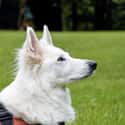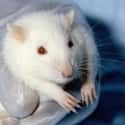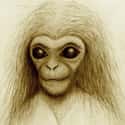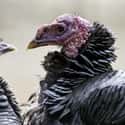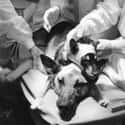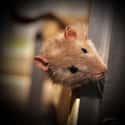-
(#1) Injected Spiders Wove Spastic Webs
In 1995, a group of NASA scientists studied the effects of various intoxicants on the web-weaving abilities of spiders. Ostensibly, they sought to determine the relative toxicity levels of the substances by examining the webs they created after injection.
What followed was most likely confirmation of anticipated results: the spider on weed wove a decent web, albeit incomplete; the spider on a stimulant wove quickly and poorly; the spider on a hallucinogenic wove a scattered, inefficient web; and the web of the spider on caffeine was off-center and asymmetrical.
-
(#2) Baby Jellyfish Were Ejected Into Space
In 1991, Dr. Dorothy Spangenberg was studying the potential effects of zero-gravity on human fetuses. Since testing her research on actual fetuses would have assuredly crossed an ethical line, she and her team packed 2,478 baby jellyfish onto the Columbia space shuttle, ejected them into orbit, and watched for results. Initially, the jellyfish adapted well to the environment, and bred themselves up to a population of 60,000.
Sadly, back on Earth, the new jellyfish were found to have greater “pulsing abnormalities” than usual – a syndrome commonly known as “vertigo.” The experiment demonstrated that, hypothetically, humans born in space might experience mobility issues once they land on Earth, similar to the phenomenon of "sea legs," often experienced by seafarers immediately after returning to land.
-
(#3) Cancer Researchers Made Frogs' Skin Transparent
To help further their insight into organ growth and tumor development, in 2007, Japanese cancer researchers at Hiroshima University actually bred transparent frogs. These frogs boasted internal organs that were completely visible through their skin.
Apparently, this innovation allows researchers to reduce the number of dissections they have to perform, since the frog's internal organs and blood vessels are all visible through their skin.
-
(#4) A Monkey's Head Was Transplanted To Another Body
American researcher Robert White performed the world's first successful monkey-head transplant in the early 1970s. In a carefully-choreographed operation, White removed a monkey's head from its body and placed it on a headless specimen. Astonishingly, the monkey awoke and tried to bite one of the surgeons. The transplant recipient survived nine days before passing.
In 2016, neurosurgeon Sergio Canavero successfully performed a monkey-head transplant. Canavero was already well-known at the time for attempting a human-head transplant in 2015.
-
(#5) Cartilage Cells Grew A Human Ear On A Mouse's Back
Nicknamed the “Vacanti mouse” for the project's lead scientist, this mouse was seeded with cow cartilage cells that had been molded into an ear shape. The result of this 1997 experiment was a disproportionate, human-ear-shaped growth on the mouse's back.
The growth was eventually removed, and the mouse went on to live a "happy, normal life." The purpose of the study, though sensationalistic at first glance, was to improve reconstructive plastic surgery techniques.
-
(#6) A Chimpanzee Was Raised Like A Human Child
While there are many accounts of children raised by animals, in 1931, psychologist Winthrop Kellogg speculated what would happen if an animal was brought up by humans to behave as a human. Kellogg brought a baby female chimpanzee named Gua into his home and raised her as if she were human, giving her the same care as their infant son, Donald. Donald and Gua were siblings in every sense except species classification. They played together, ate together, and took the same developmental tests.
While Gua performed well on the tests, she couldn’t acquire language skills – and impaired Donald’s development in the process. The Kelloggs ended the experiment after nine months, possibly because baby Donald began imitating the Gua's chimp noises. Gua was released into an animal colony, but passed only months after she left the family's home.
-
(#7) A Headless Dog Was Kept Alive
In 1940, Soviet physician Sergei Brukhonenko developed a heart-lung machine and used it to keep a headless dog alive. Just to prove his feat, he displayed the head of one of his subjects to an audience of Soviet scientists.
Under Brukhonenko's direction, the head flinched, blinked, and even ate a piece of cheese.
-
(#8) Researchers Played Jazz Music For Coke-Injected Rats
In this 2011 study, entitled "Music-induced context preference following coke conditioning in rats," rats were placed in a room and played a loop of a Miles Davis song. They were then played a loop of Beethoven. The rats seemed to prefer silence over either track, but of the two, the majority preferred Beethoven – at least, prior to the introduction of coke.
The rats were regularly injected with liquid coke for one week, and, surprisingly, most of their tastes changed from classical music to jazz. The ostensible aim of the study was to determine the neurological triggers of substance use, although the study mostly made news because of the inscrutable and somewhat quirky nature of its methods.
-
(#9) Two Dogs Were Brought Back To Life
University of California researcher Robert Cornish believed he could revive non-living organisms as long as their organs were intact. As part of his 1934 "Lazarus Project," he terminated five fox terriers and placed them in a homemade machine that circulated their blood – while simultaneously circulating a cocktail of adrenaline and anticoagulants. Cornish actually revived the last two dogs, which, though they suffered from severe brain damage, lived on for several months.
Cornish’s research passed with the dogs, however; he was disgraced for his research and dismissed from his university position. For a time, he did intend to repeat the experiment with a human volunteer .
-
(#10) Scientists Tried To Create A "Humanzee"
Russian biologist Ilia Ivanovich Ivanov, using a grant from the Soviet Government, sought to create a hybrid of a human and a chimpanzee – colloquially known as the "humanzee" – in an African lab in 1926. First, he tried to impregnate chimps with human fluids. When this failed, he planned to inseminate human women with chimp fluids.
Ivanov did manage to find a few women willing to carry a chimp baby, but all of his chimps passed in transit, and he passed in 1932 as a result of a purge of scientists.
-
(#11) A Turkey Head Mounted On A Stick Tested Turkey Mating Rituals
Martin Schein and Edgar Hale of the Pennsylvania State wanted to study what attracts one turkey to another. They started in the early 1960s with a female turkey model, removing parts one by one to see when the male would lose interest.
Left with a fake head on a stick, they took the next step and replaced the model with an actual female turkey’s severed head to test the results. The male turkeys attempted to mate with head regardless of its stick body.
-
(#12) Doctors Used Rabbits As Pregnancy Tests
Before the advent of modern urine-based pregnancy tests in the 1970s, the only way to determine whether or not someone was pregnant was the rabbit test, developed in the early 1931 by Dr. Maurice Friedman at the University of Pennsylvania Medical School. A doctor would inject a rabbit with the urine of a woman who thought she might be with child, and if the rabbit’s ovaries showed the presence of pregnancy hormone, then the test was considered positive.
While the test was extremely accurate – hailed as the first reliable medical pregnancy test – the procedure would unfortunately fell the rabbit, as an invasive operation was necessary to examine how the rabbit's ovaries were affected.
-
(#13) A Soviet Scientist Created A Two-Headed German Shepherd
One of the most famous Russian scientists is perhaps Vladimir Demikhov, best known for publicly unveiling a surgically created two-headed dog in 1959. This was performed by grafting the head, shoulders, and front legs of a puppy onto the neck of a mature German shepherd.
This was a very controversial achievement, to say the least.
-
(#14) Sheep Were Given Substances And Tasered
Taser International funded a 2010 study designed to determine whether taser hits can cause cardiac arrest in people under the influence of crystal. To test this scenario, they enlisted 16 sheep, whom they anesthetized after getting them intoxicated on an IV drip of methamphetamine hydrochloride.
The results of the study – highly-biased and morally ambiguous as it may have been – revealed that the smaller sheep may have had minor heart symptoms from the crystal, but none suffered any damage from the taser itself.
-
(#15) The Brains Of Kittens Were Replaced With Zinc And Silver
In the early 19th century, German researcher Carl August Weinhold sought to prove that the brain and nervous system were attached to one another by wires. To test his hypothesis, he removed the brains and spinal cords of several decapitated kittens and filled the cavities with zinc and silver pile batteries.
The resulting electrical charge caused the kittens' bodies to leap around for several moments before passing.
-
(#16) A Grad Student Asked Test Subjects To Take The Heads Off Rats
In 1924, University of Minnesota grad student Carney Landis designed an experiment to study the commonality of facial expressions. He exposed subjects to a variety of intense stimuli, then photographed their faces. After making them smell ammonia, look at racy pictures, and touch slimy frogs, he would carry out a live rat on a tray and ask each subject to take the head off the creature. Shockingly, most of the subjects complied.
While the psychological implications of this compliance are fascinating, nothing of interest was borne from Landis's experiment.
-
(#17) A Psychologist Separated Young Monkeys From Their Mothers
Psychologist Harry Harlow and his team conducted an experiment in 1965 that focused on the effects of isolation on monkeys. Harlow placed young monkeys who had already bonded with their mothers into small cells, all which he dubbed the “pit of despair.” Other monkeys lived in total darkness in a stainless steel box and were fed through a small hole on the roof.
Upon release, the monkeys were invariably disturbed, unable to mate or sometimes even feed themselves. Harlow was – and continues to be – criticized for the unethical nature of his experiment.
New Random Displays Display All By Ranking
About This Tool
Animal experiments have been controversial for hundreds of years, but they have widely influenced the scientific exploration of physiology, genetics, and diseases in modern medicine. Although animal experiments have helped countless scientists achieve brilliant scientific achievements, they have also inspired many people to criticize unethical experiments, even the most conservative experimental estimates.
Although scientists have developed alternative animal experiments in recent history, there are still researchers who have conducted a large number of crazy experiments on unsuspecting animals, monkeys, dogs, rats, etc., are common subjects. The random tool introduced 17 crazy animal experimentations throughout history that most people don't know.
Our data comes from Ranker, If you want to participate in the ranking of items displayed on this page, please click here.

















